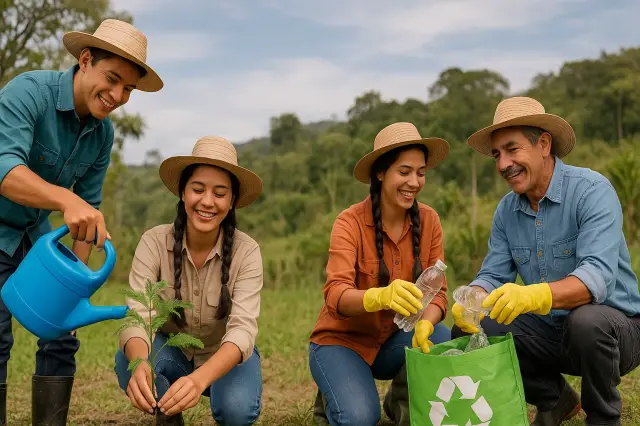In recent years, Colombia has become a Latin American benchmark in environmental sustainability. From small municipalities to large cities, Colombian initiatives have emerged that are caring for the planet with projects that combine innovation, tradition, and community commitment. These regional initiatives demonstrate that environmental protection depends not only on comprehensive national policies but also on local efforts and citizen awareness.
Environmental commitments from rural communities
In many rural areas, farmers have taken on a fundamental role in protecting the natural environment. Programs such as agroecology schools , community gardens , and reforestation projects with native species have multiplied in departments such as Boyacá, Cauca, and Antioquia.
In Boyacá , communities in the Tenza Valley are leading projects to restore degraded soils with organic fertilizers and sustainable crops.
In Cauca , indigenous associations promote the “environmental minga,” a collective practice to clean rivers and protect moorlands.
In Antioquia , municipalities such as Jardín and Támesis are promoting private nature reserves to preserve water sources.
These experiences demonstrate that Colombian initiatives that care for the planet are born from the connection between culture, land, and community.
Green innovation in Colombian cities
Inspiring projects are also flourishing in urban areas. Bogotá, Medellín, Cali, and Bucaramanga are leading efforts in sustainable mobility, recycling, and environmental education:
Bogotá has expanded its network of bike paths and promotes the use of electric bicycles through citizen incentives.
Medellín is promoting the "Medellín EcoCity" strategy, which includes tree planting, urban gardens, and green roofs.
Cali hosts "recycling for food" events, where people can exchange usable waste for agricultural products.
Bucaramanga is recognized for its "Water Guardians" program, which promotes water conservation in schools and neighborhoods.
These cities show how local actions can have a global impact in the fight against climate change.
Conservation projects in the Amazon and the Pacific
The south of the country, especially the Colombian Amazon , is home to some of the planet's greatest natural resources. There, indigenous communities and environmental organizations work on reforestation and wildlife monitoring projects.
In the department of Guaviare , programs are being developed to restore forests affected by deforestation, using satellite technology to monitor critical areas. In the Colombian Pacific , Afro-descendant groups have created cooperatives that promote responsible artisanal fishing and the protection of mangroves.
Both regions are examples of how Colombian environmental initiatives integrate ancestral knowledge with modern tools to ensure a sustainable future.
Environmental education as a driver of change
Education is one of the most important pillars of these transformations. Various foundations and schools have implemented environmental education projects to raise awareness among children and young people.
In the Coffee Region, school eco-clubs teach composting and planting practices. On the Atlantic Coast, the "Green Schools" program motivates students to create pollinator gardens. These experiences inspire a change of mindset and strengthen the country's ecological culture.
Sustainable companies and ventures
The growth of green entrepreneurship in Colombia is also worthy of recognition. Many small and medium-sized businesses are investing in biodegradable materials, circular fashion, and clean energy:
Brands like Lola Verde and Bioplaza promote plastic-free products.
In Bogotá, Recircular transforms industrial waste into new inputs for other companies.
In the Cauca Valley, young entrepreneurs are developing biogas from agricultural waste.
These Colombian initiatives that protect the planet demonstrate that sustainability can also be an economic and social development opportunity.
Ecotourism and ecosystem conservation
Ecotourism has established itself as a sustainable alternative in the country's biodiverse regions. Destinations such as Caño Cristales , the Iguaque Sanctuary , Tayrona National Natural Park , and the Tatacoa Desert implement responsible tourism policies to reduce their environmental impact.
Additionally, local communities offer conservation-based experiences, such as interpretive hikes, birdwatching, and environmental education workshops. This type of tourism fosters respect for nature and generates sustainable income.
Colombia's role in the global sustainability goals
Colombia is one of the most biodiverse countries in the world and, therefore, has a great responsibility to protect the planet. The actions carried out in the regions contribute directly to the Sustainable Development Goals (SDGs) , especially those related to clean water, life on land, affordable energy, and responsible consumption.
Every community, school, business, and citizen can be part of this change. And it is precisely from these territories that hope for a greener future is born.
